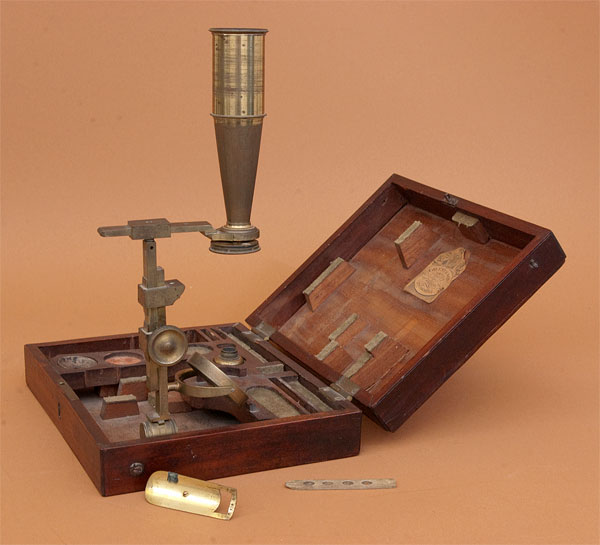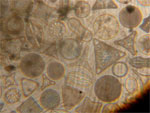 |
|||||
 |
 |
||||
 |
|||||
 |
 |
||||
Blunt & Son Chest Microscope (No. 171) |
||||||||
 |
||||||||
| Age: c1810 Made by: T. Blunt & Son Made in: England |
||||||||
 |
||||||||
 |
||||||||
|
Imaging
|
||||||||
| This is a Chest Microscope made by T. Blunt and Son at the beginning of the 19th Century. The microscope is a Gould-style brass compound microscope with conical body tube and standard three-lens optics. The rectangular pillar, which mounts on hinge in a corner of its own wood box, has a rack & pinion focus mechanism. There is no fine focus. The stage, now missing from this instrument, was probably a cruciform style common to instruments of this era. An unusual feature of this instrument is the rotating objective turret in place of the usual single objective lens. This turret has six positions with increasing magnification labeled "1" through "6". The microscope body screws into a brass arm that press-fits into a rotating bracket at the top of the pillar (this allows the microscope to rotate away from the case). The mirror has two reflecting sides, one plane and the other parabolic. Interestingly, the mirror faces toward the top hinges. Thus, the top case must be removed to use the microscope in transmitted light mode in order for the lamp to be positioned correctly. Accessories include a brass fish plate, a single bone specimen slide, and two Lieberkuhn parabolic reflectors for illuminating opaque samples. There are two identifications associated with this microscope. One is an engraving on the support pillar: T. Blunt, London, the other is the Trade Card attached to inside of box cover printed "T. Blunt & Son".
The entire microscope disassembles and folds into the mahogany chest. The chest is 23cm (w) x 18.5 (d) x 6.5 (h). The microscope is approximately 28cm tall. Thomas Blunt (c1746–1822) apprenticed c1760 to Edward Nairne (1726–1806), and became his partner in 1774. Nairne introduced the Chest Microscope with the manufacture of a Cuff-style instrument mounted on a tilting support attached to an elaborate mahogany box. Nairne continued to make instruments of this style at 22 Cornhill, London well after Blunt joined the firm. There they manufactured many "mathematical" instruments in addition to microscopes. Chest microscopes were made by a number of important opticians of the era including Dollond, Martin, Shuttleworth, and Pyefinch. Known Nairne instruments were Cuff-style, thus given the Gould body and rotating objective system and the Blunt & Son trade card, it is possible that this particular instrument was created after Nairne died, thus I have dated this c1810. Microscope featured 09/2009 |
||||||||